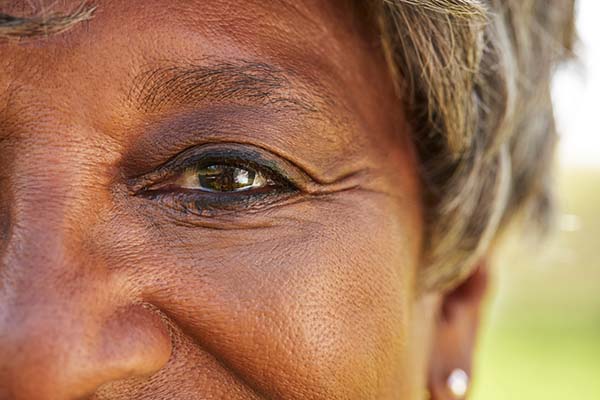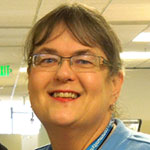Your Aging Eyes

When people hear the term “blindness,” often they assume that it is a “lights out” lack of vision. While complete lack of sight does exist, it is far more common for people to retain some vision. Low vision refers to the inability to correct vision with glasses or contact lenses and describes a functional vision loss, while blindness typically is the term used in more advanced stages of low vision.
In February, we recognize Age-Related Macular Degeneration (AMD) and Low Vision Awareness Month. AMD is the leading cause of low vision and blindness in Americans aged 60 years and older and affects 1.6 million Americans.
What is AMD? It is an eye disease that can affect your central vision. It is a common condition, affecting about 11 million people in the United States. It happens when aging causes damage to the macula — the part of the eye that controls sharp, straight-ahead vision. The macula is the center of the retina (the light-sensitive tissue at the back of the eye). AMD doesn’t typically cause complete blindness but losing your central vision can make it harder to see faces, read, drive, cook, and perform tasks around the house.
In some people it develops slowly. In other people it develops faster. If you have early AMD, you may not notice vision loss for a long time. AMD is not painful, so your eyes will not have symptoms that make it obvious there is a problem. That’s why it’s important to get regular eye exams with retinal screenings like dilation to find out if you have AMD.
There are two types of AMD:
- Dry AMD (also called Atrophic AMD) is most common. Dry AMD occurs when the retina has an inability to properly dispose of the cellular waste it naturally produces, which can occur with age. This can cause atrophy, or thinning, of the retina. Atrophy is typically the reason why people will develop vision loss and is more common in more advanced dry AMD. There is no treatment for dry AMD, but you can take steps that could stop progression to intermediate or later stages of the disease.
- Wet AMD (also called Advanced Neovascular AMD) is less common and usually causes faster vision loss. At any time, dry AMD can progress into wet AMD. It happens when abnormal blood vessels grow in the back of the eye and damage the macula. The “wet” component is so named because of the bleeding and fluid produced by the abnormal blood vessels. The good news is that there are now treatment options for wet AMD.
Typically, both eyes are affected by AMD when it occurs, but both eyes do not have to be equally affected or progress in the same manner.
What are the symptoms?
If you notice any of the following symptoms, you should see an eye doctor as soon as possible. If you are diagnosed with wet AMD, it is important to see a retina specialist for the most appropriate care.
- Blurriness that cannot be correct by glasses/contacts, wavy lines, or a blind spot
- Straight lines or faces appearing wavy
- Doorways seem crooked
- Objects appear smaller or farther away
Who is at risk for AMD?
The risk for AMD increases as you get older, so people aged 55 and older are more likely to have AMD. In addition to age, risk factors include people who:
- Have a family history of AMD
- Are or have ever been a tobacco smoker
- Have high blood pressure or high cholesterol
Gender and ethnicity may play a role in your risk factors. Talk with your health care provider.
If you’re at risk for AMD because of your age, family history, or other factors, it’s important to get regular eye exams. Ask your doctor how often you should have an eye exams. Early AMD doesn’t have any symptoms, so don’t wait for your vision to change!
Lowering your risk for AMD
Research shows that you may be able to lower your risk of AMD (or slow vision loss from AMD) by making these healthy choices:
- Avoid/quit smoking tobacco.
- Eat healthy foods, including leafy green vegetables (kale, spinach, and collard greens) and foods high in omega-3 fatty acids (salmon, sardines, mackerel, herring, and albacore tuna).
- Maintain healthy blood pressure and cholesterol levels.
- Protect your eyes. Wear sunglasses and a hat with a visor in bright sunlight to protect your eyes from potentially harmful ultra-violet (UV) light.
- Get regular physical activity.
- Maintain a healthy body weight.
Things you can do if you have low vision:
- Improve the lighting in your home and office. Warm-white LED light bulbs help to enhance the contrast of objects around the house. Adjustable goose-neck lamps that can be pointed directly your object of interest (reading, crafting) can increase functional lighting.
- Use high contrast for reading and writing. Write in large letters with a broad felt tip pen on white or light paper.
- Examine your stairs and rugs. Increase the visibility of stair edges with bright overhead lighting and/or using bright colored tapes to mark edges and/or objects that you might trip over. Consider replacing rugs which are hard to distinguish from the floor around them with a color that has better contrast (or simply remove the rug altogether). Make sure rugs are secure with rug pads or rug tape, especially around the edges.
- Use large print books or try other media, like audiobooks, books-on-tape and/or a e-reader/tablet that allows you to enlarge the font size.
- Use a handheld magnifier.
- Use the camera on your smart phone/tablet to help to enlarge text. You can take a picture of a restaurant menu and use the “pinch zoom” feature to make text seem bigger—even if the menu is behind the counter!
- Adjust the distance between yourself and the things you want to see. When things are closer, they seem bigger to our eyes and are easier to see. Simply rearranging your furniture in the living room can make it easier for you to watch TV.
 Contributor Mary Pat O’Leary, RN, BSN, is a senior planner at Aging and Disability Services, a division of the Seattle Human Services Department that serves as the Area Agency on Aging for Seattle and King County. She expressed appreciation to Joanna Toner, OD, a resident optometrist in North Seattle, for her input. Dr. Toner’s clinical experience includes primary eye care for geriatric and veteran patients as well as low vision research.
Contributor Mary Pat O’Leary, RN, BSN, is a senior planner at Aging and Disability Services, a division of the Seattle Human Services Department that serves as the Area Agency on Aging for Seattle and King County. She expressed appreciation to Joanna Toner, OD, a resident optometrist in North Seattle, for her input. Dr. Toner’s clinical experience includes primary eye care for geriatric and veteran patients as well as low vision research.
![AgeWise King County [logo]](https://www.agewisekingcounty.org/wp-content/themes/agewisekingcounty/images/logo.png)